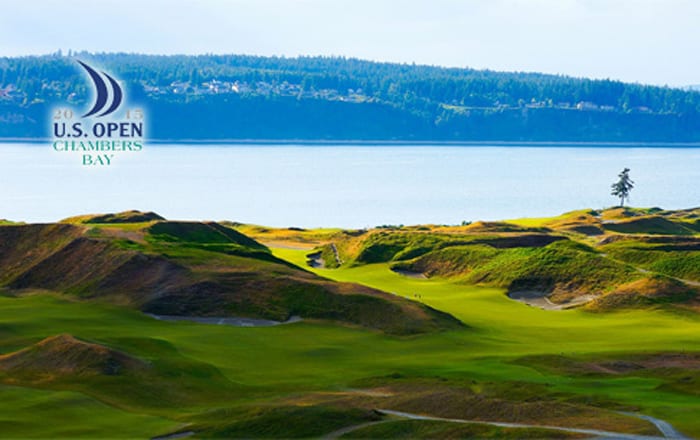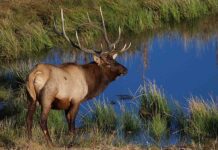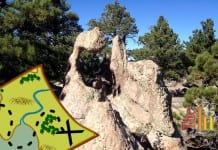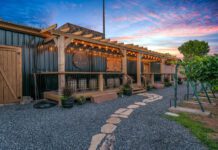
Written by Scott Dunford
It was August 2008 when I first stepped out of the shuttle bus onto the first tee at the site of what will be this year’s U.S. Open at Chambers Bay. The clubhouse sits high above the course and provides a limited view of what you can expect below. Chambers Bay is a little-known links-style golf course set on the shores of the picturesque Puget Sound, 45 minutes south of Seattle, with wide fairways and extremely elevated tees for a links course. It’s not your typical Northwest-style golf course at all! There isn’t even a pond or lake! So why stage one of the biggest golf events of the year here? Crazy, but I’ve got to say, this golf course is going cause even the best in world to scratch their heads. With the exception of local native Ryan Moore, fewer than a handful have ever played it.
My first experience with playing Chambers Bay wasn’t all that great. It was summertime in the Northwest. A hot, 90-degree day with about 40 percent humidity made it feel like we were playing in the deep South, and the heat was compounded by the fact that you weren’t allowed a golf cart unless you had a doctor’s directive. The front nine has extreme elevation changes and is very difficult to walk. A couple of holes require you to hit a severe uphill approach to a blind green. My friend and I were exhausted after that first nine holes, but thank goodness the next nine were much more manageable. At that time, the greens were not yet mature, but these fairways remain firm due to a sandy basis, one of the key reasons it was selected by the USGA officials. Other Northwest courses were considered but lacked the capability to manage large galleries, were too far away from a major airport, or didn’t have the sandy base to allow the adequate drainage necessary due to the typical rain and moisture normally associated with the Northwest.
When the shuttle bus picked us up after 18 holes at the bottom of this “golf quarry,” I asked everyone on the bus, “Would any one of you want to play this course again?” The resounding response was, “No way! Not unless they allow golf carts!” Seems that they too were all exhausted and hot and didn’t have that true Chambers Bay experience that designer Robert Trent Jones Jr. had imagined for us. No doubt he was influenced by Mike Keiser’s vision when he created Bandon Dunes golf resort in Coos Bay, Oregon—the closest thing to an experience in Ireland on courses like Royal Portrush and Royal Country Down, with beautiful sand dunes and wide fairways, and it’s open to the public.
You may already know a bit about Mr. Keiser. He’s also responsible for creating the other four resort courses at Bandon Dunes Resort: Pacific Dunes, Brandon Trails, Old Macdonald, and Bandon Preserve—a par 3 course that’s always in Golf Digest’s top 5 or 10 best-rated courses to play. Like Chambers Bay, all require walking or hiring caddies. I guess Mr. Jones and Mr. Keiser feel it’s the only way to truly appreciate the links design and tradition of Old Scottish golf. Everything is a bit understated compared to what you’d find at a Trump resort. It’s all about golf as our forefathers envisioned. Regardless of the difficulty in walking these tracks, you can’t help but feel that you’ve checked one more thing off your bucket list. They are all incredible! My advice to you, however, is not to play them when the weather is too hot and humid. I’d rather play in the rain than on a hot day like the one we had, especially if I’m required to walk.
I can’t wait to see how the best in the world fare on this relatively new course. It may not be lush and green. It may even have some bare spots on the fairways. Some of the players have been pretty vocal about this gravel and sand quarry, which was transformed by Robert Trent Jones, Jr. into a linksy gem. According to tour player Michael Putnam, who lives about a half-mile from the course in Tacoma, “It’s in horrible shape most of the year!” It seems the heavy public traffic has reportedly turned some of the delicate fescue greens into dirt riddled with moss. I can’t imagine that being the case for this year’s U.S. Open, but I guess we’ll soon see for ourselves. It really doesn’t provide the optimum Northwest golf experience you’d expect to see. There is only one lone Douglas fir tree on the par 3 -15th signature hole, something that is very unusual for the Northwest. I believe someone tried to cut it down a few years ago, but they were able to save it. What some will do to be famous, even if it’s for something like that.
I’ve had the good fortune over the years to play several world-class golf courses featured in major USGA televised events. It’s always fun to share stories with fellow golfers, such as “when I played that hole, I hit it in that same place!” I know my old golf buddies from the Northwest will be there, walking shoulder-to-shoulder with golf’s greatest as they pull off shots that astound us and transport us into believing they’re godlike. If you ever make it out to the Northwest for a golf trip, consider playing these other awesome courses as well: Pronghorn (Nicklaus Signature) Bend, Ore.; Sunriver Resort (Crosswater) Sunriver, Ore.; Pumpkin Ridge (Ghost Creek) North Plains, Ore.; Gold Mountain (Olympic) Bremerton, Wash.; and Sandpines Florence, Ore. True Northwest golf at its finest! See ya on the links.




